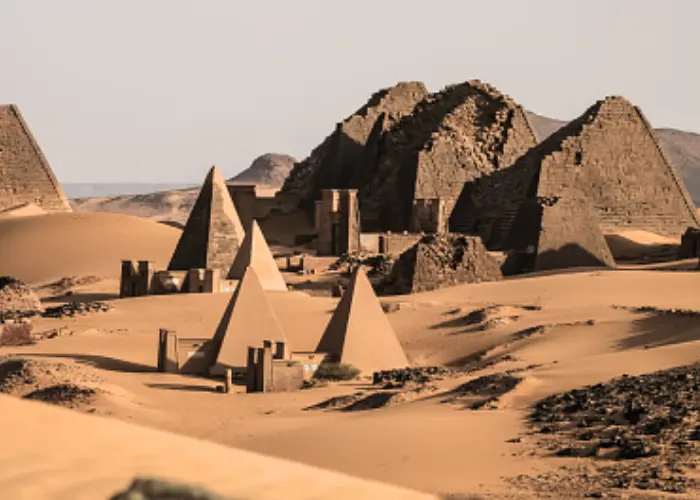A Discovery at Temple of Amenhotep: Giant Sphinxes Depicting King Tut’s Grandfather Unearthed!

The discovery of two giant sphinxes at the ancient Temple of Amenhotep depicting King Tut’s grandfather has been a remarkable excavation in the history of ancient Egypt. The sphinxes were dug up and dusted off near the ancient city of Luxor, revealing the spectacular figures of a long-lost past.
These stunning monuments, which date back to the 18th dynasty of ancient Egypt, depict King Tut’s grandfather, Amenhotep III. He ruled from 1391-1353 BC. The size and intricate detail of these Sphinxes measure over 20 feet long. These are a testament to the grandeur and wealth of the ancient Egyptian civilization during the reign of Amenhotep III.
This find sheds new light on the reign of Amenhotep III and provides further context for the discovery of King Tut’s tomb. Read more about the fascinating history of King Tut’s reign and the discovery of his tomb in our previous article:
discovery of king tuts tomb Tutankhamun
Where did King Tutankhamun get his Dagger
The uncovering of these Sphinxes provides valuable insights into the following:
- art
- religion
- personal power of the King
- political power of the King
This article will delve into the significance of this historical event, how the sphinxes were unearthed, and how it helped uncover a lost period in Egypt’s history.
The Temple of Amenhotep III and King Tut:

Amenhotep III was an ancient Egyptian pharaoh who ruled from 1391 to 1353 BC during the 18th dynasty. He was one of the most powerful and influential pharaohs of ancient Egypt. Amenhotep III was known for his impressive building projects, including the Temple of Amenhotep at Luxor.
After his death, his son Akhenaten took the throne. He immediately began changing Egypt’s religion from polytheism to monotheism, centred around one god. The successors of Akhenaten, including Tutankhamun, were later forced to restore the actual religious practices of the country.
King Tutankhamun, also known as King Tut, was an Egyptian pharaoh of the 18th dynasty (ruled c. 1332–1323 BC) during the period of the New Kingdom. He became pharaoh young after his father’s death, Akhenaten. Despite his relatively short reign, King Tut is one of the most well-known pharaohs due to the discovery of his nearly intact tomb by British archaeologist Howard Carter in 1922.
Location of Two Giant Sphinxes:

The temple is in the ancient city of Thebes, near modern-day Luxor, Egypt. The sphinxes are carved from solid sandstone blocks and are believed to have been part of the temple’s original decoration.
The two sphinxes were discovered during an excavation of the temple in the early 20th century. They measure over 20 feet in length and are depicted as lions with human heads, a characteristic typical of ancient Egyptian sphinxes. The faces of the sphinxes are carved in the likeness of King Tut’s grandfather, Amenhotep III. Ancient people are believed to symbolize the king’s power and dominance over the land.
The Temple of Amenhotep is one of Egypt’s largest and most well-preserved temples. The discovery of the two giant sphinxes has added to the temple’s historical significance. The temple was dedicated to the sun god Ra. It was built during the reign of King Tut’s grandfather. King Tut’s father, Akhenaten, later modified it.
Excavation of the Sphinxes:
It was not until the early 20th century that the two giant sphinxes depicting king Tut’s grandfather were first excavated. After removing the overlying sand, the full forms of the sphinxes were revealed, complete with the head and body of Amenhotep III.
The details of the figures were still intact, demonstrating the impressive craftsmanship used to create the sculptures. In addition to the sphinxes, this excavation also uncovered several other artifacts. It provided insight into the life and reign of Amenhotep III, including hieroglyphic inscriptions and statues of the pharaoh.
Significance of this Discovery:

The discovery of these two giant sphinxes profoundly impacted the archaeological world. By unveiling the hidden artifacts of Amenhotep III’s reign, scholars were given the unique opportunity to gain further insight into this long-lost period in Egypt’s history.
The details of the Sphinxes helped to better understand the lives and customs of those living in ancient Egypt and the various religious and political practices during the 18th Dynasty. Furthermore, the excavated artifacts help us better understand the relationship between Amenhotep III and his grandchild, King Tutankhamun.






